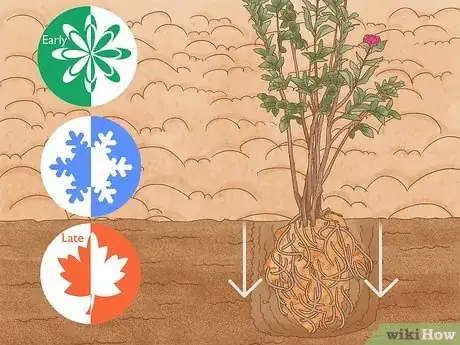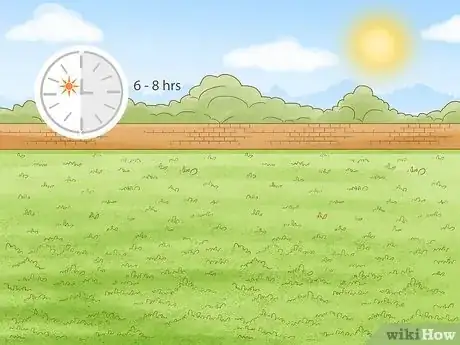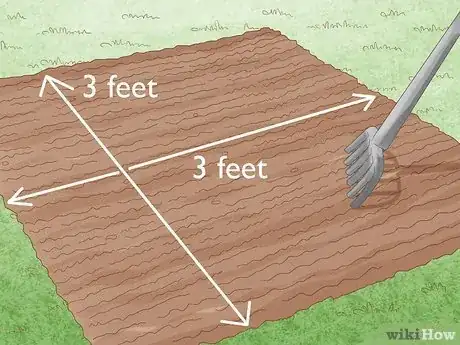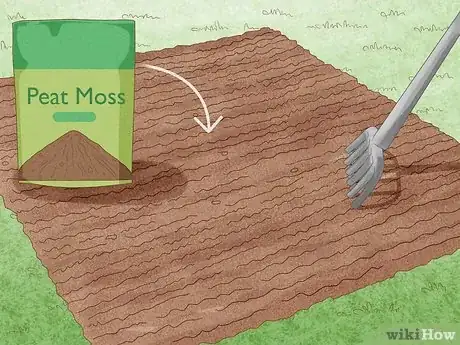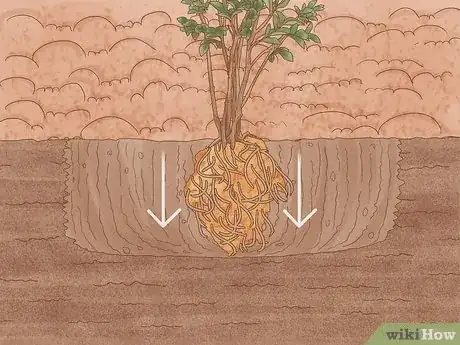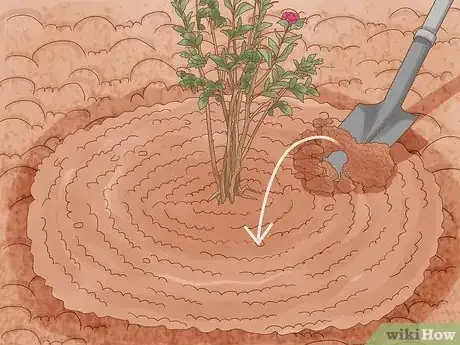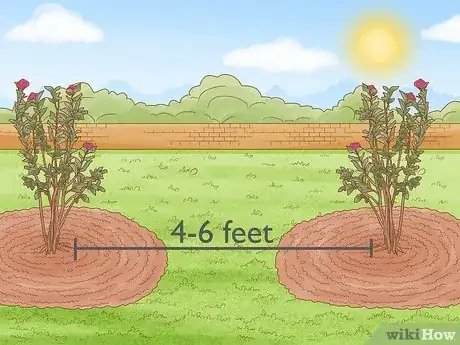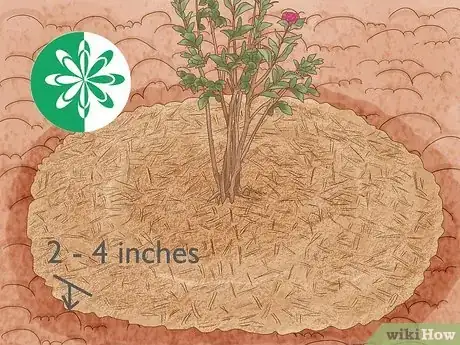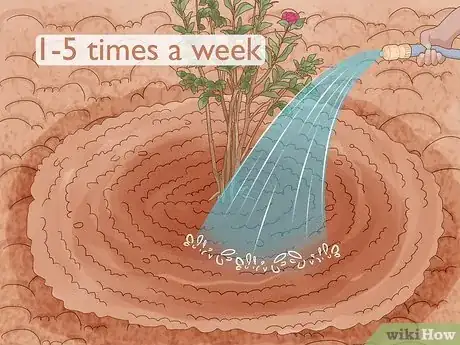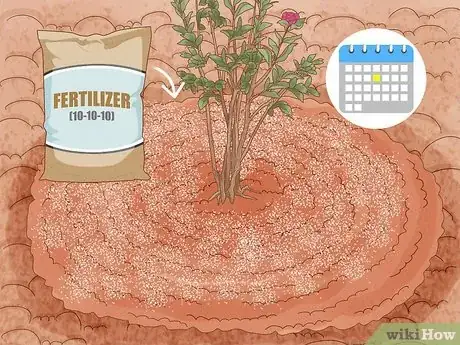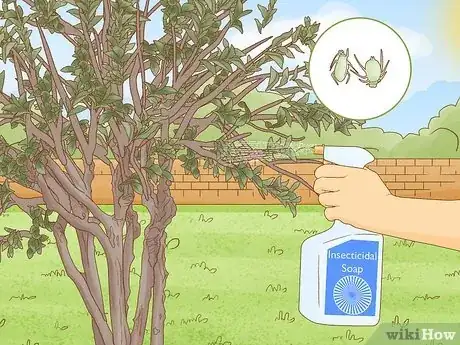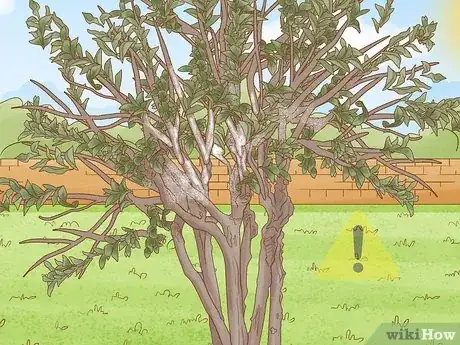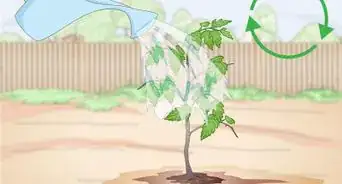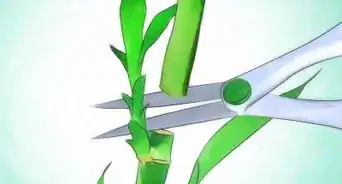This article was co-authored by Lauren Kurtz. Lauren Kurtz is a Naturalist and Horticultural Specialist. Lauren has worked for Aurora, Colorado managing the Water-Wise Garden at Aurora Municipal Center for the Water Conservation Department. She earned a BA in Environmental and Sustainability Studies from Western Michigan University in 2014.
There are 11 references cited in this article, which can be found at the bottom of the page.
wikiHow marks an article as reader-approved once it receives enough positive feedback. In this case, several readers have written to tell us that this article was helpful to them, earning it our reader-approved status.
This article has been viewed 244,744 times.
Crepe myrtles are summer flowering trees admired for their vibrant pink, red, purple, and white blossoms. Their natural beauty, resilience, and minimal need for tending make them a welcome addition to any yard or garden. Since the trees thrive in warm, humid conditions, they’ll do best in a well-drained patch of soil somewhere they can receive plenty of direct sunlight. Once you’ve planted your crepe myrtles, spread mulch around the base of the trunk to protect against moisture loss, apply a well-balanced fertilizer once a year, and water as needed to keep them producing healthy, flowers when they return each season.
Steps
Preparing the Soil
-
1Plant crepe myrtles late in the year. The best time to raise crepe myrtles is in late fall, winter, or early spring, just after the plant's cold weather dormant season. You can also hold off until fall or winter roll around, provided you live in a region with mild temperatures where the ground does not regularly freeze.[1]
- If you wait until fall or winter to plant your crepe myrtles, they won’t begin sprouting leaves until the weather warms up.[2]
- Avoid planting crepe myrtles at the tail end of summer. Without the necessary warmth, the tree won’t be able to survive.
-
2Pick out a sunny spot for your growing site. Crepe myrtles need lots of light to flourish. If possible, choose a location that receives a minimum of 6 to 8 hours of direct sunlight per day. An open stretch near the center of your yard or garden is usually the best place to situate a young crepe myrtle.[3]
- Plant your crepe myrtle a sufficient distance away from your home, tall fence lines, and other objects that might cast too much shade.
- A crepe myrtle can be perfect for filling in sections of landscaping that are too hot or bright for more temperate plants.[4]
Advertisement -
3Till the soil. In order for your crepe myrtle to successfully take root, it’s necessary to start with soil that’s loose and well-drained. Clear a patch roughly 3 feet (0.91 m) long by 3 feet (0.91 m) wide, taking care to remove any nearby vegetation that may compete for nutrients. Then, aerate the soil by breaking it up lightly using a shovel or rake.[5]
- Take the time to turn the soil down to its lower layers, rather than just loosening the topsoil.
-
4Amend dry soil with organic material to make it more hospitable. If the soil you’re growing on is particularly dense or sandy, it may be helpful to mix in a little peat moss or well-rotted manure. These additives help the soil retain key moisture and nutrients. You can also use garden compost or a few handfuls of native plant food, as long as it’s evenly distributed throughout the entire plant bed.[6]
- Crepe myrtle has no problem getting by on basic nutrients like nitrogen, potassium, and phosphorous, which are found in most commercial fertilizer mixes.
- Inconsistent pockets of poorly-mixed fertilizer in the soil can stall the development of healthy roots.
-
5Bring the soil to a pH level between 6.0 and 7.3. You can increase the acidity of the soil by mixing in organic matter like manure or garden compost. To lower the acidity instead, add a small amount of ground agricultural lime. Use either substance sparingly and incrementally to taking the pH too far in the other direction.[7]
- Test the pH of the soil before and after adding other substances to keep track of changes in the acidity.
- You can purchase a soil testing kit at your local gardening supply store or plant nursery.
Planting the Crepe Myrtle
-
1Dig a hole roughly three times as wide as the root ball. Scoop out the loose soil on the site you tilled previously. The hole should be approximately the same depth as the nursery pot holding the plant. It’s not a good idea to seat the root ball any deeper, as the soil around it needs to stay oxygenated.[8]
- If necessary, measure the height of the nursery pot before digging the hole. The top of the root ball should be just about level with the uppermost layer of soil.
- Because of their intensive germination requirements, crepe myrtles headed for home gardens are almost always grown from saplings.
-
2Place the root ball inside the hole. Extract the crepe myrtle from its nursery pot and lower it into the hole. Be careful not to damage the roots or supple trunk in any way. Once you’ve got the tree in the ground, pack some of the loose soil around the base to hold it in place.
- Always handle saplings by their root balls, not by their trunks.
- Laying the nursery pot on its side may make it easier to remove the crepe myrtle without disturbing the delicate trunk or root system.
-
3Fill in the hole. Push the remaining soil in around the roots and trunk. Then, tamp it down lightly to anchor the tree. The soil should be compacted firmly enough to prevent shifting or erosion, but still loose enough to allow the roots to expand.[9]
-
4Plant multiple crepe myrtles in rows. Space the trees roughly 4–6 feet (1.2–1.8 m) apart to make sure they have plenty of room to reach out as they grow. Larger specimens like Muskogee and Natchez should have as much as 6–8 feet (1.8–2.4 m) between them.
- Be sure to research the average size of the species you're planting so you'll know how much space you can expect it to take up.[10]
- If you're planting your crepe myrtles near a fenceline or retaining wall, make sure you leave at least 3 feet (0.91 m) of intervening space. This will prevent the growing trees from overtaking their surroundings.
- You can also plant double rows to create a privacy screen or wind cover. In this case, you'll want to stagger the rows so that they're offset and leave 3 feet (0.91 m) of space between each.[11]
Caring for Crepe Myrtle
-
1Mulch around the base of the tree. Spread 2 to 4 inches (7.6 to 12.7 cm) of rich hardwood mulch around the tree. A thick layer will help the roots hold moisture and discourage the growth of weeds, which can sap the trees nutrients.
- Leave about half a foot (0.15 m) of space between the mulch layer and the trunk. Piling on mulch too closely or too heavily can smother the roots and endanger the life of the tree.
- Apply 2-3 inches of new mulch each spring when the tree begins flowering.[12]
-
2Water your crepe myrtle 1-5 times a week. Young crepe myrtles need a healthy drink at least once a week while they’re dormant and temperatures are cool, and up to five times a week in hot weather or especially dry soil. Continue on this watering schedule for the first two months. Afterward, go back to wetting them thoroughly once a week.[13]
- Water occasionally during periods of drought to keep your crepe myrtle thriving.
-
3Fertilize the tree once a month during the first year. Any slow-release organic fertilizer will work just fine—a well-balanced 10-10-10 mix is a popular choice with many gardeners. Apply the fertilizer to the soil liberally in early spring as soon as the first leaves start to appear. Following the first growing season, cut back to fertilizing once a year.[14]
- Lightly fertilizing established older trees every 2-3 weeks can help them produce healthy new growth.
- Crepe myrtles are well-suited for a variety of soil types, and don’t need to be fed as much as other trees of similar size.[15]
-
4Prune crepe myrtles late in the winter. Crepe myrtles are naturally shapely trees, and typically only call for light pruning. Cut away dead branches while the flowers are dormant to free up room for healthy new growth come spring. This is also a good time to remove lower limbs to help shape the tree as it develops and decrease its overall volume.
- Promote airflow around the trunk by trimming basal shoots, thick clusters of twigs, and intertwining branches.
- Avoid over-pruning (also commonly referred to as “crepe murder.”) Trimming too much growth at once can weaken the tree and leave it susceptible to damage and disease.[16]
-
5Keep an eye out for harmful pests. Crepe myrtles are a favorite of common garden pests like aphids and Japanese beetles. Ward off occasional invaders by spraying them with a mild insecticidal soap. In many cases, eliminating unwanted insects will also take care of a persistent mold problem.[17]
- Another option is to remove and relocate larger pests by hand whenever you come across them.
- If you're battling a full-fledged infestation, it may be necessary to have your crepe myrtles sprayed with an organic insecticide.
-
6Inspect your crepe myrtle regularly for signs of disease. Powdery mildew, black mold, and leaf spot are a few of the threats that crepe myrtles face once they begin flowering. In most cases, the effects these cause are harmless, and will clear up on their own in time. Positioning your trees where they can enjoy full sunlight and good air circulation and inspecting them frequently goes a long way in preventing disease.[18]
- Prune back trees afflicted by mold and mildew to increase the airflow around the trunk. Throw away any cut branches and disinfect your pruning tools before you use them again so the disease doesn't spread.
- Diseases that don't clear up on their own after a few weeks can often be knocked out with a commercial chemical fungicide like Daconil or Immunox. Be sure to follow the directions provided on the label of the product you’re using to avoid harming the tree.[19]
Expert Q&A
Did you know you can get expert answers for this article?
Unlock expert answers by supporting wikiHow
-
QuestionHow can I revive my droopy and dry tree?
 Lauren KurtzLauren Kurtz is a Naturalist and Horticultural Specialist. Lauren has worked for Aurora, Colorado managing the Water-Wise Garden at Aurora Municipal Center for the Water Conservation Department. She earned a BA in Environmental and Sustainability Studies from Western Michigan University in 2014.
Lauren KurtzLauren Kurtz is a Naturalist and Horticultural Specialist. Lauren has worked for Aurora, Colorado managing the Water-Wise Garden at Aurora Municipal Center for the Water Conservation Department. She earned a BA in Environmental and Sustainability Studies from Western Michigan University in 2014.
Professional Gardener
-
QuestionMy crepe myrtle has foliage but it's not showing any buds. What can I do to get it to grow?
 Lauren KurtzLauren Kurtz is a Naturalist and Horticultural Specialist. Lauren has worked for Aurora, Colorado managing the Water-Wise Garden at Aurora Municipal Center for the Water Conservation Department. She earned a BA in Environmental and Sustainability Studies from Western Michigan University in 2014.
Lauren KurtzLauren Kurtz is a Naturalist and Horticultural Specialist. Lauren has worked for Aurora, Colorado managing the Water-Wise Garden at Aurora Municipal Center for the Water Conservation Department. She earned a BA in Environmental and Sustainability Studies from Western Michigan University in 2014.
Professional Gardener
-
QuestionAll the leaves on my young crepe myrtle are red. Is this normal?
 Community AnswerYes. There are many variations of color for crepe myrtle trees. Though not as common as the other mostly pink colors, a red color is nothing to worry about.
Community AnswerYes. There are many variations of color for crepe myrtle trees. Though not as common as the other mostly pink colors, a red color is nothing to worry about.
Things You'll Need
- Crepe myrtle sapling
- Balanced fertilizer
- Organic amendment material
- Ground agricultural lime or sulfur soil (optional)
- Hardwood mulch
- Insecticide soap
- Organic insecticide
- Commercial fungicide spray
- Pea gravel
- Shovel
- Rake
- Hand trowel
- Pruning shears
References
- ↑ http://www.dannylipford.com/growing-crape-myrtles/
- ↑ https://www.thetreecenter.com/how-to-plant-crape-myrtle-trees/
- ↑ https://www.todayshomeowner.com/growing-crape-myrtles/
- ↑ https://www.thetreecenter.com/how-to-plant-crape-myrtle-trees/
- ↑ https://www.thetreecenter.com/how-to-plant-crape-myrtle-trees/
- ↑ https://www.thetreecenter.com/how-to-plant-crape-myrtle-trees/
- ↑ https://www.todayshomeowner.com/growing-crape-myrtles/
- ↑ https://www.southernliving.com/home-garden/gardens/how-to-plant-a-crepe-myrtle#how-to-plant-a-crepe-myrtle_2
- ↑ https://www.southernliving.com/home-garden/gardens/how-to-plant-a-crepe-myrtle#how-to-plant-a-crepe-myrtle_2
- ↑ https://www.thetreecenter.com/crape-myrtle-varieties-and-guide/
- ↑ https://www.fast-growing-trees.com/blog/crape-myrtles-you-wont-believe-these-different-varieties/
- ↑ http://www.garden.org/plantguide/?q=show&id=2093
- ↑ https://www.todayshomeowner.com/growing-crape-myrtles/
- ↑ https://www.southernliving.com/garden/grumpy-gardener/when-should-you-fertilize-crepe-myrtle
- ↑ https://www.southernliving.com/garden/grumpy-gardener/when-should-you-fertilize-crepe-myrtle
- ↑ https://www.southernliving.com/garden/grumpy-gardener/crepe-myrtle
- ↑ https://hgic.clemson.edu/factsheet/crape-myrtle-diseases-insect-pests/
- ↑ https://www.fast-growing-trees.com/blog/crape-myrtle-problem-fix/
- ↑ https://www.southernliving.com/garden/grumpy-gardener/crepe-myrtle
About This Article
To grow crepe myrtle, start by planting a crepe myrtle sapling in a sunny outdoor spot in late fall, winter, or early spring. When you plant your crepe myrtle, plant it in a hole that's 3 times as wide as the sapling's root ball. Next, spread a layer of hardwood mulch around the tree to help the soil retain moisture. Then, water your crepe myrtle once a week when temperatures are cool and up to 5 times a week during hot weather. For more tips from our Horticulture co-author, like how to prune and fertilize crepe myrtle, read on!
